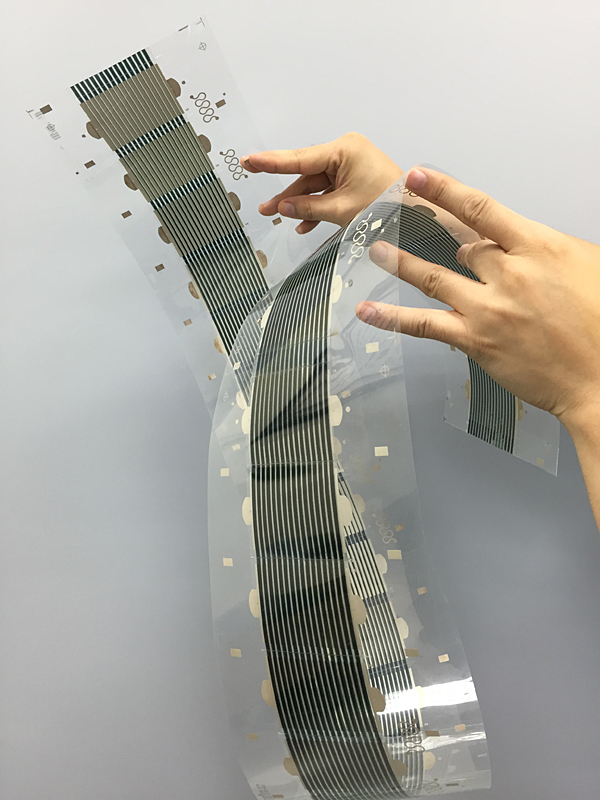New Materials Yield Record Efficiency Polymer Solar Cells

Temperature-controlled aggregation in a family of new semi-conducting polymers appears to be the key to creating highly efficient organic solar cells that can be mass produced more cheaply.
Polymer solar cells are a delicately controlled mixture of a polymer donor and a fullerene acceptor. The cell is created by adding a solvent to the polymer and fullerene until the mixture becomes a liquid, then spreading the liquid thinly onto a surface.
As the solvent evaporates, the thin layer solidifies, with the donor material hardening into tiny, highly ordered “clumps” that are connected by other, disordered donor molecules, and the acceptor weaving around them. Currently the most efficient organic solar cells are manufactured using one of only two different fullerenes.
NC State physicist Harald Ade and postdoctoral researcher Wei Ma had previously studied the morphology of solar cells and found that the size scale of the clumps within the donor layer and the aggregation – or interaction between neighboring molecules within the layers – were the main drivers of solar cell efficiency.
In a paper published today in Nature Communications, Ade, Ma and a team of chemists from the Hong Kong University of Science and Technology led by He Yan show that size scale and aggregation within these devices are strongly temperature dependent.
They also show that record efficiencies of up to 10.8 percent – as opposed to the currently published 9.8 percent – are achievable with the substitution of numerous fullerenes. Additionally, this performance can be achieved in thick film devices.
“Once we saw how temperature affected the aggregation and morphology of these solar cells, it allowed the chemists more freedom to play with different chemical compositions in the active layer,” Ade says. “Yan’s team demonstrated 10 percent efficiency with 10different mixtures, and in thicker films.
So these solar cells could be compatible with existing methods of mass production, like slot die casting and roll-to-roll processing similar to newspaper printing, rather than the more expensive production methods currently in use that are required for thickness control.
“We hope that these findings will allow others to experiment with different polymer:fullerene blends, further increasing the efficiency of solar cells, decreasing their production costs and leading to a commercially viable alternative source of energy.”
-peake-
Note to editors: The abstract of the paper follows.
“Aggregation and morphology control enables multiple cases of high-efficiency polymer solar cells”
Authors: Yuhang Liu, Jingbo Zhao, Zhengke Li, Cheng Mu, Huawei Hu, Kui Jiang, Haoran Lin, and He Yan, Hong Kong University of Science and Technology; Harald Ade and Wei Ma, North Carolina State University
Published: Online in Nature Communications
DOI: 10.1038/ncomms6293
Abstract: Although the field of polymer solar cell has seen much progress in device performance in the past few years, several limitations are holding back its further development. For instance, current high-efficiency (>9.0%) cells are restricted to material combinations that are based on limited donor polymers and only one specific fullerene acceptor. Here we report the achievement of high-performance (efficiencies up to 10.8%, fill factors up to 77%) thick-film polymer solar cells for multiple polymer:fullerene combinations via the formation of a near-ideal polymer:fullerene morphology that contains highly crystalline yet reasonably small polymer domains. This morphology is controlled by the temperature-dependent aggregation behavior of the donor polymers and is insensitive to the choice of fullerenes. The uncovered aggregation and design rules yield three high-efficiency (>10%) donor polymers and will allow further synthetic advances and matching of both the polymer and fullerene materials, potentially leading to significantly improved performance and increased design flexibility.
Media Contact
More Information:
http://news.ncsu.edu/2014/11/efficient-solar-cell/All latest news from the category: Materials Sciences
Materials management deals with the research, development, manufacturing and processing of raw and industrial materials. Key aspects here are biological and medical issues, which play an increasingly important role in this field.
innovations-report offers in-depth articles related to the development and application of materials and the structure and properties of new materials.
Newest articles

Superradiant atoms could push the boundaries of how precisely time can be measured
Superradiant atoms can help us measure time more precisely than ever. In a new study, researchers from the University of Copenhagen present a new method for measuring the time interval,…

Ion thermoelectric conversion devices for near room temperature
The electrode sheet of the thermoelectric device consists of ionic hydrogel, which is sandwiched between the electrodes to form, and the Prussian blue on the electrode undergoes a redox reaction…

Zap Energy achieves 37-million-degree temperatures in a compact device
New publication reports record electron temperatures for a small-scale, sheared-flow-stabilized Z-pinch fusion device. In the nine decades since humans first produced fusion reactions, only a few fusion technologies have demonstrated…





















